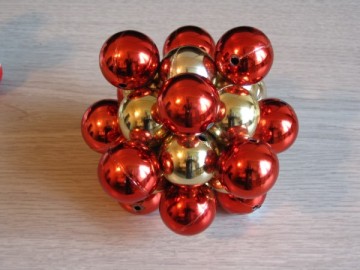.jpg)

Diamond
.jpg)



Fluorine
Rhodium Nucleus
White Tin
Neutron Decacores
A Synopsis Of Nuclear Waste Treatment Processes
The effective treatment of nuclear waste using chemo-nuclear reactions based in the Hydreno Atomic model and a variety of other novel science is essentially a given. The only limiting factors are the lack of political will, financial commitment and the refusal to believe facts which are contrary to well entrenched, but incorrect dogmas.
Various Nuclear waste (Radwaste) treatment methods, now exceeding a dozen, are proposed for investigation, some of which are already approaching industrial application. The principles employed, include sub-critical fission reactions attended by greatly accelerated decay sequences and low energy induced fusion and cold fission reactions that produce only stable end products.
Photo-Deactivation:
Also known as Photoremediation, this process utilizes monochromatic gamma radiation tuned to induce giant dipole nuclear resonance to promote sub-critical fission reactions and greatly accelerated decay sequences through disruptive harmonic vibration of the unstable target nuclei. The process was extensively developed by the late Dr. Paul Brown.
ZIPP Fusion & Fission:
Variations and refinements of the authors Passive Inertial Confinement Fusion process utilizing plasma discharges to produce High Density Electron Clusters or Electron Valudum (EV) in conjunction with cavitation bubble collapse. The resulting coherence of Zero-Point energy via Casimir effects causes a wide variety of nuclear reactions including cold fissions, low energy induced fusions and accelerated decay chains.
Hydroxy Gas - MMX Process:
The implosion of quasi-stable hydrogen oxide (hydroxy) gas produced from an excited state of water is used in conjunction with a proprietary molten metal matrix containing the radwaste. Microscopic implosions within the matrix cause ZPE coherence resulting in cold fission and low energy fusion reactions in a manner similar to that produce by the ZIPP fusion process. Hydroxy gas is produced in a variety of pulsed electrolysis systems including those developed by the late Stanley Meyers and Yull Brown.
Monti Process:
Involves a proprietary firing mixture of powdered materials including Carbon, nitrogen and oxygen compounds and various metals capable of facilitating low energy fission and fusion reactions when ignited to produce white-hot radiant energy frequencies. The white hot burn sequence produces prolific bubbling that evidently results in Zero-Point energy coherence through cavitation bubble collapse within the molten metal. The process was developed by Dr. Roberto Monti, apparently based on ancient alchemy or hyperchemistry.
Keller Catalytic Process:
Similar in many respects to the Monti method, evidently using a Thermite reaction with the addition of a proprietary catalyst for initiating nuclear reactions at relatively low thermal energy inputs in the range of about 1000 to 5,000 °C. Thermal induced atomic and nuclear resonance within the molten metal matrix in conjunction with nuclear scale Casimir effects causes a variety stabilizing nuclear reactions.
RIPPLE Fission:
Utilizes a supersonic ionized gas to vapour heat exchanger to envelope the radwaste aerosol in a vacuum induced plasma vortex, which is capable of harmonic disruption of the matter sustaining Zero-Point field resulting in production of stable light elements from heavy metals such as Lead, Mercury and Americium. Target materials undergo a form of nuclear spalation which quite literally chips away at the nucleus gradually reducing it to lighter elements such as hydrogen and oxygen.
Plasma Arc Implosion:
An electrical plasma arc produced from a conventional arc welder is used to produce implosive ball lightning with prolific EV production. The resulting discharge is used to confine an aerosol of radwaste causing a variety of nuclear stabilizing reactions in a manner similar to both ZIPP and RIPPLE Fission.
Scalar Interferometry:
This process Involves the interference of Scalar/Longitudinal EM waves to modify or disrupt the matter stabilizing frequencies of the Zero-Point field in a defined region of space or by direct excitation of the nucleus at harmonic frequencies resulting in greatly accelerated nuclear decay to stable end products in target materials enveloped by the scalar field.
Bio-Nuclear Remediation:
Utilizes the high voltage gradients, dielectric micro-cavities (ie contractile vacuoles, etc) and scalar wave frequencies believed common to living systems to modify the Zero-Point Field causing cold fission, fusion and accelerated decay reactions. These reactions occur widely in nature, explaining all manner of mass balance anomolies in agronomy, medicine and elsewhere and have been researched extensively by Louis Kervran and others.
LENTEC Processes:
Novel Electrolytic Cells and operating regimes are employed to produce Low Energy Nuclear Transmutations (LENT) using High Density Electron Clusters (HIDEC) or EVís, which induce nuclear reactions in the electrolyte and electrode materials containing the targeted radwaste. This method is based in part on the foundational work of Pons' and Fleishmann's controversial cold fusion experiments.
PIT Processes:
Plasma Injected or Induced Transmutations (PIT) processes utilize various glow discharge and HIDEC or High Density Charge Cluster (HDCC) phenomena within rarified gaseous atmospheres to effect transmutations through the apparent coherence of the local ZPF.
© 2006, 2007
.jpg)
Cuboctacores
Updated Mar 17/07